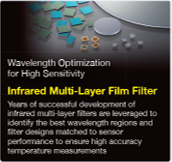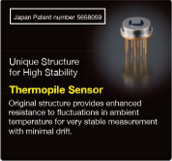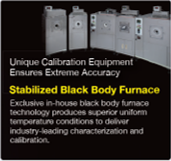Abstract
In various industries, the demand for non-contact temperature measurement are increasing, and the requirements are diverse. We have developed an infrared thermometer IT-270, which can be customized with specifications such as measurement wavelength, target size etc. We can propose the optimum combination of these specifications matching to the user’s measurement needs. We introduce a customization example for SiC wafer temperature measurement, which has been attracting attention as a power semiconductor.

Sho FUJINO
Thermometry Team
Semiconductor Solution Department,Materials & Semiconductor Center
HORIBA, Ltd.

Yu TAKIGUCHI
Thermometry Team
Semiconductor Solution Department,Materials & Semiconductor Center
HORIBA, Ltd.
► Click Here for original paper (PDF file)
Introduction
In various industries, the demand for temperature measurement are increasing. Especially the requirement of high accuracy non-contact temperature measurement has become more important for quality control of products in semiconductor, steel, food, etc. An infrared thermometer, which is a non-contact thermometer, detects the infrared ray radiated from the surface of the object and converts them into a temperature value. The measurement objects are various such as Si and SiC wafers, which are in vacuum chambers of semiconductor manufacturing equipment, and SUS and quartz, which are chamber parts. The required target size depends on the measurement object size and the distance between the infrared thermometer and the measurement object. The communication interface between the PLC (Programable Logic Controller) of semiconductor manufacturing equipment and the infrared thermometer is different depending on the customer request. In addition, since infrared thermometers are installed in various locations, there are concerns about measurement errors due to radiation from chamber parts other than the measurement object. The commercial product lineups cannot meet all of these diverse requirements. Therefore, we have developed an infrared thermometer IT-270, which can be easily customized to meet the main specifications such as measurement temperature range, measurement wavelength, target size, and communication interface.
In this article, we will explain the principle of the infrared thermometer. Then we will introduce the customization range of IT-270, and its basic specifications and performance and a customization example for SiC wafer temperature measurement, which has been attracting attention as a power semiconductor.
Principle
Materials in the world are composed of atoms and molecules which generate thermal vibrations according to their thermal energy (temperature) and emit electromagnetic waves in accordance with their frequency (wavelength). A hot steel plate at 1000⁰C radiates electromagnetic waves between infrared ray and visible light. We can see this visible light and feel the infrared ray on the skin. However, objects below 200⁰C or near room temperature emit only weak infrared ray that we cannot detect visually, and the thermal radiation energy is also very weak, making it difficult to feel it on the skin. The infrared thermometer detects this electromagnetic wave (thermal radiation energy) and converts it into temperature. Infrared ray is emitted at relatively any temperature and is used in general infrared thermometers.
We use the thermopile sensor, which is one of the infrared sensors. Figure 1 shows the structure of an infrared thermometer and a thermopile sensor.
A thermopile is composed of many thermocouples connected in series. It is composed of two different metals, and the temperature difference(ΔT) between the hot junction and the cold junction generates the thermal electromotive power based on the temperature difference.
Infrared rays from a measuring object are concentrated in the hot junction by the infrared condensing lens. The measurement wavelength is limited by an infrared filter installed in front of the thermopile sensor. The thermopile outputs a voltage (i.e., thermal electromotive power) corresponding to the relative temperature difference between a measuring object and the thermometer (i.e., the cold junction). In order to calculate the absolute temperature of a measuring object, the temperature of the cold junction is measured by a thermistor installed in the thermopile sensor.
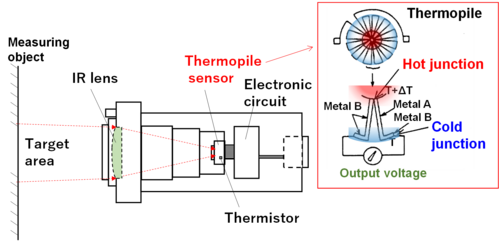
Figure 1 The structure of infrared thermometer and thermopile sensor.
Features
The most attractive feature of IT-270 is its customizability. We can propose the optimum combination of the main specifications for target size, measurement temperature range, measurement wavelength, and communication interface matching to the user’s measurement needs. Various improvements were also made in terms of basic performance. The detector is the same thermopile sensor used in our conventional product IT-470F-H[1], which has industry-leading accuracy and reproducibility. The new design of the internal structure of the thermometer has made it more resistant to the effects of ambient temperature and electromagnetic noise than our conventional models. Furthermore, it is less than one-half the footprint and less than one-quarter the volume, realizing a space-saving design (Figure 2).

Figure 2 Picture of IT-270.
Customizability
The user usually selects a product from the commercial lineup of infrared thermometers with specifications such as target size, measurement temperature range, measurement wavelength, and communication interface that match the user’s application. However, it is difficult to find a product that meets all the specifications. Especially for semiconductor manufacturing equipment, it is necessary to consider various factors such as window materials, special measurement objects and installation positions. The scope of what can be handled within commercial products is limited. We developed IT-270 to allow customization of the target size, measurement temperature range, measurement wavelength, and communication interface (Figure 3). IT-270 is composed in the lens unit and the sensor unit and can meet a variety of temperature measurement needs in combination with these two units. For the communication interface of IT-270, the signal converter “IT-27C” (option) can be customized to meet the user requirements.

Figure 3 The customizability of IT-270.
The sensor unit can also be customized to the measurement wavelength by utilizing an infrared filter and thermopile sensor, which are supported by years of know-how and a track record of success across many industries. The customizable wavelength range is 3-14 μm (Figure 4). The sensor unit is customized to match not only the transmission characteristics of infrared window materials such as sapphire and calcium fluoride but also the spectral characteristics of various measurement objects[2].
It is important to optimize the target size according to the measurement situation, such as the size of the measuring object and the distance between the thermometer and the measuring object. The lens is designed to be able to customize the target size.

Figure 4 The customizable wavelength range and Application example by IT-270.
Figure 5 shows the customizable target size in IT-270. Three models of lens units for IT-270 are available for short, medium, and long distances, depending on the measuring distance. The short-distance model excels in measurement at distances of 100 mm or less. The middle-distance model is easy to use for relatively large measuring objects at middle distance. The long-distance model is selected when you want to narrow the target size as much as possible at a long distance. In addition, the target size characteristics can be customized among these three models to provide the optimum characteristics for each user application.
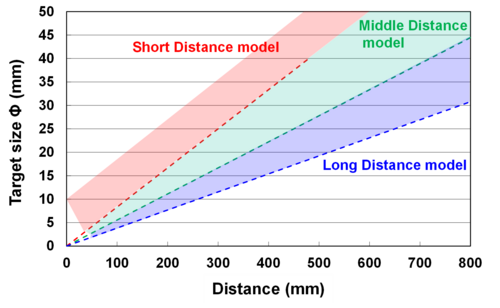
Figure 5 The target size characteristics supported by IT-270.
Customized functions related to the communication interface are integrated into the signal converter IT-27C (option) which is the input/output unit. This allows communication functions to be customized without affecting the basic performance of IT-270. In the future, we intend to support EtherCATTM communication, etc., in accordance with user needs. The communication between IT-270 and IT-27C uses half-duplex RS-485 communication. It is possible to communicate directly with IT-270 without the signal converter IT-27C by using RS-485 communication.
Industry-leading accuracy
In some cases, individual differences in measuring values in infrared thermometers can be problematic, such as when multiple infrared thermometers are used to measure temperature distribution or when they are mounted in multiple chambers. IT-270 has achieved industry-leading accuracy, which is a very small individual difference in measuring value between thermometers, thanks to a uniquely developed thermopile sensor, a precision blackbody furnace with excellent temperature uniformity, and an infrared filter with a long track record. Table 1 shows a customized example of the basic specification of IT-270. Figure 6 shows accuracy test results in the basic specification model. The plot shows the mean value of the measurement error, and the error bar shows the standard deviation (2σ) of the measurement error for the 20 units. As mentioned above, IT-270 excels in the relatively low temperature range of 200⁰C or below, ensuring a measurement error within ±0.4⁰C at blackbody furnace temperatures of 100~200℃.
Table 1 The customized example of basic specification of IT-270.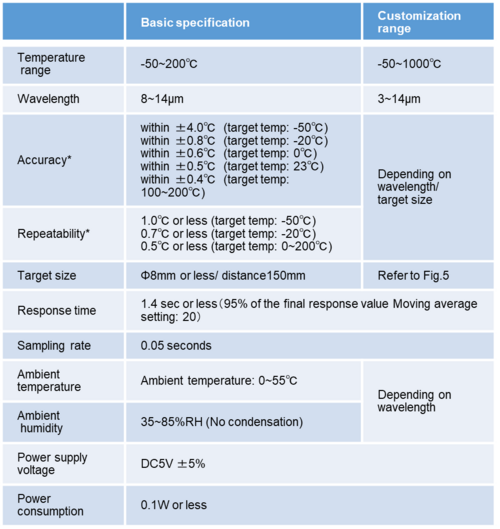
*Ambient temperature is between 24⁰C and 29⁰C (including the temperature of thermometer mounting part), relative humidity is 55% ±20%, and emissivity setting is 1.000, No disturbance(ex. electrical noise, transient change of ambient temperature).
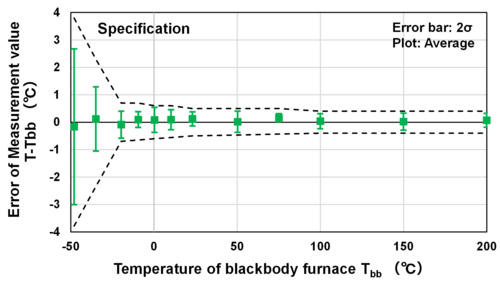
Figure 6 The accuracy test result in basic specification model(N=20).
Internal structure resistant to ambient temperature and electromagnetic noise
In general infrared thermometers, when the ambient temperature changes rapidly, the temperature distribution in the thermometer causes measurement error. The individual difference in measurement error is affected by the temperature distribution, which occurs with mechanical and assembly tolerances. Therefore, it was necessary to stabilize the temperature around the infrared thermometer and at the mounting position. On the other hand, in the case of semiconductor manufacturing equipment, there are heat/cooling sources such as RF power supplies, various heaters, and chillers. So, the temperature around the infrared thermometer and at the mounting location often changes transiently during the process. We researched the factors that cause individual mechanical differences and redesigned the internal structure to achieve an internal structure that is resistant to ambient temperature effects while ensuring customizability. Figure 7 shows the stability against a transient change in ambient temperature. When the ambient temperature changes from 25⁰C to 55⁰C in 30 minutes, the measurement error of IT-270 for 20 units is less than ±1⁰C.
Another concern is the effect of electromagnetic noise when mounted in a plasma chamber. IT-270 uses PCB connectors to eliminate the cables, which can be antennas, and has a double shielded PCB case connected to the common line and a housing case connected to the ground line.
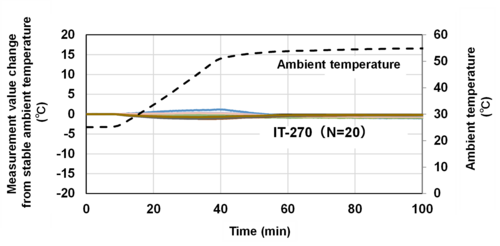
Figure 7 The stability against transient change of ambient temperature (Target temperature 200℃, N=20).
Customization example for SiC wafer temperature measurement
The features of IT-270 have been described so far, and here we will introduce an application example of IT-270 to silicon carbide (SiC) wafer temperature measurement by customizing the measurement wavelength. SiC devices are a type of power semiconductor and have been actively researched and developed for practical use because of their ability to reduce power loss compared to conventional Si devices. In the Si semiconductor process, wafer temperature control has traditionally been important in the anneal process. As the miniaturization of semiconductor devices progresses, wafer temperature control has become more important in all semiconductor processes, including the cleaning process and dry etching process.
In the future, SiC devices will also require wafer temperature control in various processes, and the need for non-contact wafer temperature measurement will increase.
In the case of SiC temperature measurement in a chamber, the infrared thermometer detects not only infrared ray radiated from the measuring object but also infrared ray radiated from chamber parts and reflected or transmitted on the wafer surface. In the annealing process, the chamber parts and wafer reach over 1,000⁰C with no temperature difference between chamber parts and wafer. Therefore, it seems that the temperature of the SiC wafer can apparently be measured. However, when the SiC wafer temperature is relatively low (less than 200⁰C) or the temperature of the chamber parts changes transiently during the process, measurement error occurs due to reflected/transmitted infrared ray. In order to reduce this measurement error, it is necessary to select the measurement wavelength that has the highest emissivity of SiC. Figure 8 shows the spectrum of emissivity and transmittance spectrum of single-crystal 4H-N SiC wafer. The emissivity of SiC changes greatly with wavelength. It is difficult to use a wavelength of about 1 μm, which is used for temperature measurement in anneal process because of the higher transmittance of SiC. Furthermore, it is difficult to use the general infrared thermometer with wavelength of 8-14 μm since there is a reflection peak at about 12 μm, where the emissivity drops significantly. Therefore, we developed a customized IT-270, which selected the measurement wavelength with high emissivity, no transmittance, and low reflectance of SiC.

Figure 8 The spectrum of emissivity and transmittance of single crystal 4H-N SiC wafer.
Figure 9 shows the measurement result of the SiC wafer in a general infrared thermometer with a wavelength 8-14 μm and a customized IT-270. The SiC emissivity of a general infrared thermometer is low about 0.3, so a large measurement error occurs depending on the disturbance temperature because the disturbance infrared ray radiated from chamber parts is reflected on the wafer surface. On the other hand, the SiC emissivity of the customized IT-270 is about 0.9 which is 3 times higher than that of a general infrared thermometer with a wavelength of 8-14 μm, so you can see that the measurement error against disturbance temperature decreases very well.

Figure 9 The measurement result of SiC wafer.
Thus, the measurement wavelength customization of the IT-270 enables non-contact measurement of SiC wafer temperature even for SiC wafers below 200⁰C, where the chamber member temperature changes transiently.
Conclusion
We have developed an infrared thermometer IT-270 which can be customized for target size, measurement wavelength and communication interface. IT-270 meets the user’s needs for non-contact temperature measurement under a wide variety of conditions. Temperature control is important in every industry, and there are many needs for non-contact temperature measurement.
On the other hand, an infrared thermometer that can measure temperature without contact is affected by the surface condition of the measuring object and several disturbances from surrounding heat sources, etc. Recently, production lines in all industries, not only semiconductor manufacturing processes, have become more complex, and more precise temperature measurement accuracy is required. The scope of what can be handled within commercial products is limited.
We believe that IT-270 has the potential to meet even these difficult measurement needs. Customized IT-270 has been evaluated by semiconductor equipment manufacturers and semiconductor companies. With our many years of experience in infrared thermometer products, we would like to work closely with our customers in order to solve as many temperature measurement problems as possible.
* “Industry leading accuracy” mentioned in this paper is the result of 2023 in-house study.
* EtherCAT is a trademark or registered trademark of Beckhoff Automation GmbH.
References
[1] Readout, 2014, No.43, p.2-6
[2] Readout, 2020, No.54, p.81-84
Product & Exhibition Information, Contact Information
HORIBA’s infrared thermometer integrate a variety of proprietary technologies into a single unit. We offer industry leading accuracy supported by years of know-how in infrared sensor development and a track record of success across many industries.
e-Readout Editorial Office:
Research & Development Division, HORIBA, Ltd.
2, Miyanohigashi-cho, Kisshoin, Minami-ku, Kyoto 601-8510, Japan

